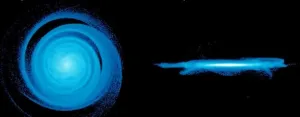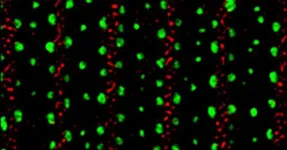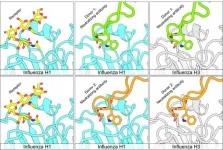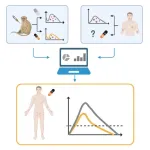(Press-News.org) Scientists at St. Jude Children’s Research Hospital revealed the complex structure of two Parkinson’s disease-related proteins, both of which are implicated in late-onset cases. Leucine-rich repeat kinase 2 (LRRK2) is a protein kinase that modifies other proteins in a process called phosphorylation; Rab29, a member of the Rab GTPase family that regulates cellular trafficking, modulates the activity of LRRK2. How Rab29 and LRRK2 work synergistically to cause Parkinson’s disease remains unclear. The St. Jude researchers determined the structures of LRRK2 bound to Rab29, uncovering mysteries behind LRRK2 regulation and insights with implications for drug design. The work was published today in Science.
Parkinson’s disease is the second-most common neurodegenerative disease after Alzheimer’s disease and affects 1-2% of the population older than 65 years. The genetic link to the disease is well-known, with approximately 15% of cases presenting a family history. While there is a long list of genes associated with the disease, mutation of LRRK2 is one of the most common causes. Due to its large size, structural studies on LRRK2 have been cumbersome.
“This protein is extremely challenging to work with,” said corresponding author Ji Sun, PhD, St. Jude Department of Structural Biology.
Despite those difficulties, Sun and his team presented the first structure of full-length LRRK2 in 2021 in Cell.
“In that first paper, we got the structure of LRRK2, but that structure showed an inactive conformation,” Sun explained. Proteins often have active and inactive forms, regulated by different cellular signals. Sometimes, it takes binding to another protein to trigger the structural changes that move a protein from an inactive shape to an active one. “So, we started thinking, ‘We have one key state of LRRK2. Can we get its active conformation?’”
Cryo-electron microscopy captures the active state of LRRK2
The search for the active conformation was not as simple as adding Rab29 to LRRK2. LRRK2 can bind to other LRRK2 molecules in a process called oligomerization. This can turn a single LRRK2 monomer (one unit) into a dimer (two units) — or even larger assemblies. This meant the researchers had to search for the version that represented the active form. There was also the issue that Rab29 is located at cell membranes.
“In cells, about 90% or more LRRK2 is cytosolic,” explained Sun, referring to the cytosol, the liquid that the cell membrane encloses, containing many of the components of the cell. “A very small amount is located on the membrane surface and forms large oligomers. And those are the versions that are active and functional.”
Using cryo-electron microscopy, the researchers, including first author Hanwen Zhu, PhD, St. Jude Department of Structural Biology, determined the first structures of the Rab29-LRRK2 complex. This included the structures of the monomer (one pair) and dimer (two pairs) but also an unexpected tetramer (four pairs). “We are really excited about the structural findings, as they represent the first high-resolution LRRK2 structures captured in its active state,” Zhu said.
“In this tetramer, we see the active conformation of LRRK2, but in the monomer and dimer complexes, LRRK2 is in an inactive conformation,” Sun added.
Understanding the Rab29-LRRK2 complex
These findings demonstrate that LRRK2 is activated not just by what proteins it interacts with but also by their spatial arrangement within cells.
“We propose a transition from monomer to tetramer upon membrane recruitment,” Sun explained. “Inside the cell, it’s mostly inactive monomers or dimers of LRRK2. But when Rab29 recruits LRRK2 to the membrane, the local concentration of LRRK2 increases. This then facilitates the transition to tetramer, wherein LRRK2 becomes active.”
What are the implications for Parkinson’s disease? These structures provide researchers with an atomic-scale map to trace how the different mutations that cause Parkinson’s disease affect function within this complex.
“All those mutations actually favor the active conformation, meaning they provide new interactions in the active conformation or disrupt interactions within the inactive conformation,” Sun said. “The effects of the mutations can be visualized beautifully in our structures; it’s very well explained.”
The importance of such structural studies lies not just in the insight gained but also in their potential application for drug design. For example, the researchers also captured the structure of LRRK2 in the presence of the drug DNL201. This drug, which went through a phase 1 clinical trial, locks the protein in an active state, so it was used to validate their findings that the tetramer was indeed the active form of the complex.
“We now have an inactive conformation and an active conformation, so we can monitor the transition from the inactive to active state,” Sun explained. “These structures provide much-needed insights for medicinal chemists to design novel inhibitors against LRRK2 for Parkinson’s treatment.”
Authors and funding
The study’s other first author is Francesca Tonelli, University of Dundee. Other authors include Martin Turk, St. Jude, and Dario Alessi, University of Dundee.
The study was supported by grants from the National Institutes of Health (R00HL143037 and R01NS129795), the UK Medical Research Council (MC_UU_00018/1), Aligning Science Across Parkinson’s (ASAP) (ASAP-000463) through the Michael J. Fox Foundation for Parkinson’s Research (MJFF) and ALSAC, the fundraising and awareness organization of St. Jude.
St. Jude Media Relations Contacts
Chelsea Bryant
Desk: (901) 595-0564
Cell: (256) 244-2048
chelsea.bryant@stjude.org
media@stjude.org
Rae Lyn Rushing
Desk: (901) 595-4419
Cell: (901) 686-2597
Raelyn.rushing@stjude.org
media@stjude.org
St. Jude Children’s Research Hospital
St. Jude Children’s Research Hospital is leading the way the world understands, treats and cures childhood cancer, sickle cell disease and other life-threatening disorders. It is the only National Cancer Institute-designated Comprehensive Cancer Center devoted solely to children. Treatments developed at St. Jude have helped push the overall childhood cancer survival rate from 20% to 80% since the hospital opened more than 60 years ago. St. Jude shares the breakthroughs it makes to help doctors and researchers at local hospitals and cancer centers around the world improve the quality of treatment and care for even more children. To learn more, visit stjude.org, read St. Jude Progress blog, and follow St. Jude on social media at @stjuderesearch.
END
Structures of Parkinson’s disease-linked proteins offer a framework for understanding how they work together
2023-12-21
ELSE PRESS RELEASES FROM THIS DATE:
Male breast cancer diagnosis fuels groundbreaking treatment tool
2023-12-21
Doctors diagnosed Christopher Gregg, Ph.D., member of the Nuclear Control of Cell Growth and Differentiation Program at Huntsman Cancer Institute at the University of Utah (the U) and neuroscientist and professor of neurobiology and human genetics at the U, with stage 4 metastatic breast cancer in 2018. At that point, he started thinking of ways to improve his treatment.
“The core problem of metastatic cancer is it evolves,” says Gregg. “There may be a treatment that works today but eventually ...
NASA’s Hubble watches ‘spoke season’ on Saturn
2023-12-21
This photo of Saturn was taken by NASA's Hubble Space Telescope on October 22, 2023, when the ringed planet was approximately 850 million miles from Earth. Hubble's ultra-sharp vision reveals a phenomenon called ring spokes.
Saturn's spokes are transient features that rotate along with the rings. Their ghostly appearance only persists for two or three rotations around Saturn. During active periods, freshly-formed spokes continuously add to the pattern.
In 1981, NASA's Voyager 2 first photographed the ring spokes. NASA's Cassini orbiter also saw the spokes during its 13-year-long mission that ended in 2017.
Hubble continues ...
Astronomers detect seismic ripples in ancient galactic disk
2023-12-21
A new snapshot of an ancient, far-off galaxy could help scientists understand how it formed and the origins of our own Milky Way.
At more than 12 billion years old, BRI 1335-0417 is the oldest and furthest known spiral galaxy in our universe.
Lead author Dr Takafumi Tsukui said a state-of-the-art telescope called ALMA allowed them to look at this ancient galaxy in much greater detail.
“Specifically, we were interested in how gas was moving into and throughout the galaxy,” Dr Tsukui said.
“Gas is a key ingredient for forming stars and can give ...
Exercise prescription: Pioneering the "third pole" for clinical health management
2023-12-21
Professor Chen Shiyi's team at Huashan Hospital of Fudan University commented on the concept, policy, development and prospect of exercise prescription in the context of " Health for All", which was published in Research (10.34133/research.0284) under the title of " Exercise Prescription: Pioneering the “Third Pole” for Clinical Health Management".
Modern lifestyles have led to reduced physical activity and a rise in chronic diseases from a young age. Exercise ...
Inside the matrix: Nanoscale patterns revealed within model research organism
2023-12-21
Species throughout the animal kingdom feature vital interfaces between the outermost layers of their bodies and the environment. Intricate microscopic structures—featured on the outer skin layers of humans, as one example—are known to assemble in matrix patterns.
But how these complex structures, known as apical extracellular matrices (aECMs) are assembled into elaborately woven architectures has remained an elusive question.
Now, following years of research and the power of a technologically advanced instrument, University of California San Diego scientists have unraveled the underpinnings ...
Urology treatment studies show increased reporting of harmful effects
2023-12-21
Waltham — December 11, 2023 —
In recent years, clinical trial reports in major urology journals have been more likely to include data on harmful effects of treatments, reports a study in the January issue of The Journal of Urology®, an Official Journal of the American Urological Association (AUA). The journal is published in the Lippincott portfolio by Wolters Kluwer.
"Our analysis finds a marked increase in reporting of potential harms in randomized treatment trials ...
New type of antibody shows promise against multiple forms of flu virus
2023-12-21
Researchers have identified a previously unrecognized class of antibodies—immune system proteins that protect against disease—that appear capable of neutralizing multiple forms of flu virus. These findings, which could contribute to development of more broadly protective flu vaccines, will publish December 21st by Holly Simmons of the University of Pittsburgh School of Medicine, US, and colleagues in the open access journal PLOS Biology.
A flu vaccine prompts the immune system to make antibodies that can bind to a viral protein ...
Despite use of tecovirimat since the beginning of the 2022 mpox outbreak, few data have been published on its antiviral effect in humans
2023-12-21
Despite use of tecovirimat since the beginning of the 2022 mpox outbreak, few data have been published on its antiviral effect in humans; this study predicts the impact of early tecovirimat administration on the time to viral clearance in patients with mpox infection, using an integrative modeling approach combining pre-clinical and clinical data
#####
In your coverage, please use this URL to provide access to the freely available paper in PLOS Biology: http://journals.plos.org/plosbiology/article?id=10.1371/journal.pbio.3002249
Article Title: Early administration of tecovirimat shortens the time to mpox clearance ...
How technology and economics can help save endangered species
2023-12-21
COLUMBUS, Ohio – A lot has changed in the world since the Endangered Species Act (ESA) was enacted 50 years ago in December 1973.
Two researchers at The Ohio State University were among a group of experts invited by the journal Science to discuss how the ESA has evolved and what its future might hold.
Tanya Berger-Wolf, faculty director of Ohio State’s Translational Data Analytics Institute, led a group that wrote on “Sustainable, trustworthy, human-technology partnership.” Amy Ando, professor and chair of the university’s Department of Agricultural, Environmental, and Development Economics, ...
Sniffing women’s tears reduces aggressive behavior in men
2023-12-21
New research, publishing December 21st in the open access journal in PLOS Biology, shows that tears from women contain chemicals that block aggression in men. The study led by Shani Agron at the Weizmann Institute of Science, Israel, finds that sniffing tears leads to reduced brain activity related to aggression, which results is less aggressive behavior.
Male aggression in rodents is known to be blocked when they smell female tears. This is an example of social chemosignaling, a process that is common in animals but less common—or less understood—in humans. To determine whether tears have the same affect in people, ...








